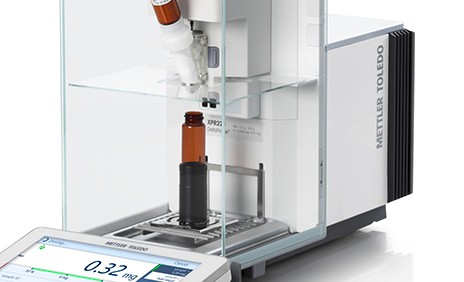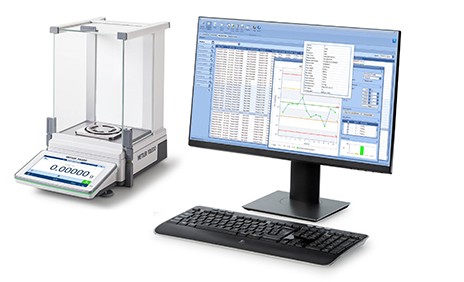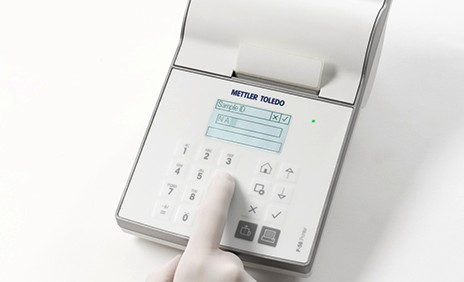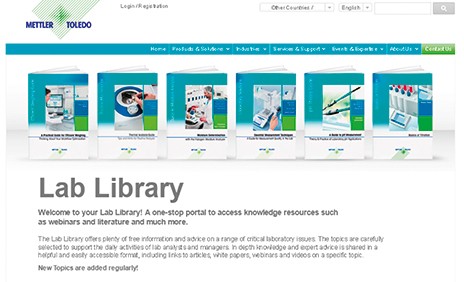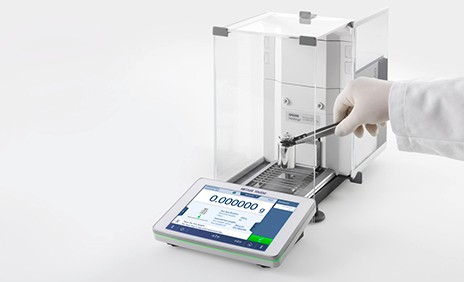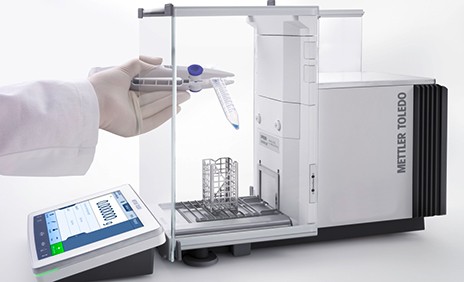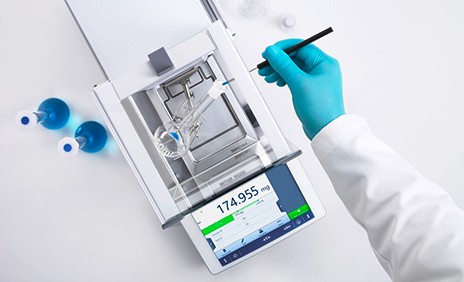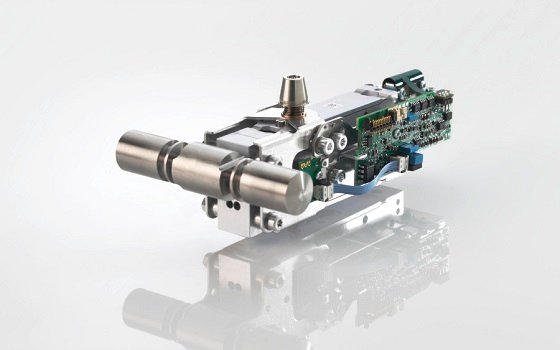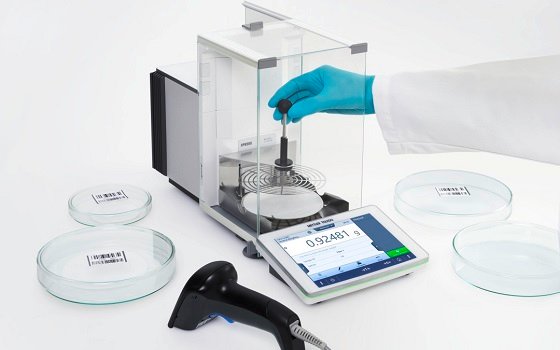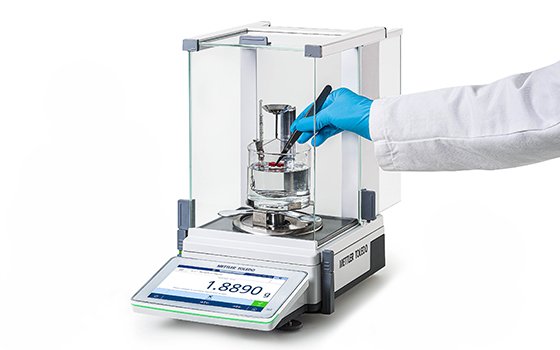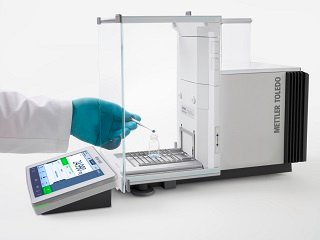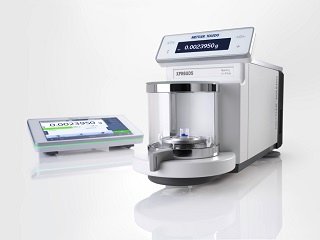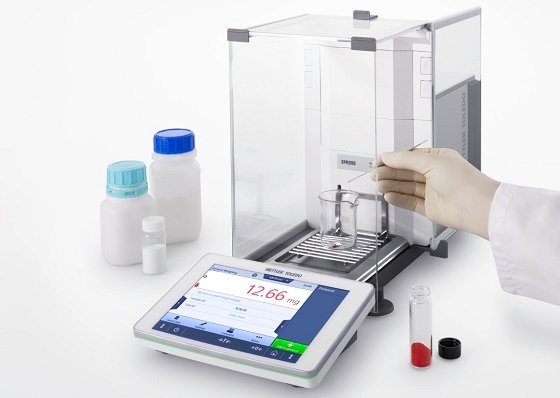
Analytical Balances
High-Performance Weighing Equipment for the Laboratory
An analytical balance is a highly precise measuring instrument used to determine the mass of small samples with a high degree of accuracy and precision. It is commonly used in scientific research, analytical chemistry, and quality control settings, where minuscule variations in weight can have significant effects. With a capacity ranging from 22 to 520 g and readability from 0.001 to 1 mg, METTLER TOLEDO analytical balances are perfectly suited to sensitive applications, such as density determination, sample preparation, differential weighing, formulation, and pipette calibration.
Advantages of METTLER TOLEDO's Analytical Balances
Easy Cleaning
Cleaning your analytical balance is quick and easy thanks to clever design features, such as fast-release draft shields and the hanging weighing pan. Read more

High-Performance Weighing Cells
METTLER TOLEDO weighing cells are expertly designed and precisely engineered to deliver accurate and reliable results.
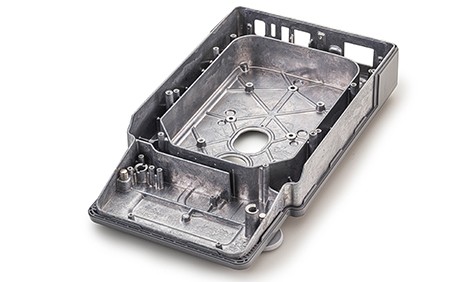
Robustly Built for Longevity
Metal casings, overload protection, and high-quality materials ensure your analytical balance will perform reliably for many years to come.
- 1 mg Analytical Balances
- 200g Analytical Balance
- 4-Digit Analytical Balances
- 5-Digit Analytical Balances
- Analytical Balance 0.0001 g
- Analytical Balance 0.0001 mg
- Analytical Balance 0.001 mg
- Analytical Balance 0.01 mg
- Analytical Balance Scales
- Analytical Balances for Academic Use
- Analytical Balances for Chemical Analysis
- Analytical Balances for Multiple Users
- Analytical Balances for Pharmaceuticals
- Analytical Balances for Research and Development
- Analytical Balances with a Touch Screen
- Analytical Balances with Bluetooth Connectivity
- Analytical Balances with Compliance Reporting
- Analytical Balances with Internal Calibration
- Analytical Balances with Touchless Sensors
- Analytical Lab Balance
- Analytical Scales
- Balances with a High-Resolution Display
- Compact Analytical Balances
- Digital Analytical Balance
- Dual-Range Capability Analytical Balances
- Electronic Analytical Balances
- High Precision Analytical Balances
- Semi Micro Balances
- Uncertainty of Analytical Balance
- XPR Automatic Balance
- XPR Essential Analytical Balances
FAQs
- What is an analytical balance?
- How does a typical analytical balance function?
- How can I use an analytical balance?
- How do I clean an analytical balance? How often should analytical balances be cleaned?
- What is the difference between zero and tare?
- Where are analytical balances used? What are the typical application areas of analytical balances?
- How do I select the right analytical balance for my weighing application?
- How can I manage data on an analytical balance?
- How can I transfer my weighing results to a computer?
- What is the difference between an analytical balance and a microbalance?
- What is the difference between an analytical balance and an electronic balance?
- Do I need to calibrate my analytical balance?
- How should I calibrate my analytical balance?
- What is scale measurement uncertainty?
- How to avoid analytical balance weighing errors?
- What is the uncertainty of an analytical balance?
- What is the analytical balance's minimum weight?
- What is the precision of an analytical balance, and what is the accuracy of an analytical balance? What is the difference and how can I test them?
- What are the effects of static electricity on an analytical balance?
- How can I eliminate static charges?
- What is a laboratory liquid dispenser and how is it used in weighing?
- What is the range of an analytical balance?
- How can I quickly identify the capacity of an analytical balance?
- What does the C mean in the analytical balance model name XPR226CDR?
- What is the maximum and minimum load that can be weighed on an analytical balance?
- What is the analytical balance bubble, and what is it used for?
- Where can I find the level bubble on my analytical balance?
- What types of analytical balances are available?
- How is an analytical balance different from a precision balance?
- What are the types of balances available?
- What is the scale division (d) and the verification scale division (e)?
- How can I weigh small samples on my analytical balance?
- How accurate is an analytical balance?
- What is the performance of an analytical balance?
- What is an approved balance? When do I need a legal for trade balance?
- Is my analytical balance legal for trade?
- How are analytical balances made?
- What is the most used analytical balance?
- Why do I need to level an analytical balance?
- How do I level an analytical balance?
- How to use my analytical balance in a sustainable way?
- What is the best analytical balance?
- What does the DU mean in the XPR Analytical Balance names (example: XPR205DU)?
- What does DR mean in the XPR Analytical Balance names (example: XPR205DR)?
- What does the H mean in XPR Analytical Balance names (example: XPR106DUH)?
- What does the Q mean in the XPR Analytical Balance names (example: XPR106DUHQ)?
- What do the numbers mean in the XPR Analytical Balance names?
- What does the name XPR stand for in the analytical balance?
What is an analytical balance?
An analytical balance, also known as a semi-analytical balance, is a type of laboratory instrument that measures mass to a high degree of accuracy, typically having a readability of 0.1 mg (four decimal places) or smaller. An analytical balance has a highly sensitive weighing cell and thus is built with a draft shield to protect the sample and the container from air movements, which can cause instability and inaccurate results. Analytical balances from METTLER TOLEDO offer a weighing capacity from 22 g to 520 g and readability ranging from 0.001 mg to 1 mg.
Modern analytical balances are often equipped with various functions and features to help maintain accuracy and improve weighing ergonomics, such as internal testing and adjustment, intuitive touchscreen operation, quality assurance, and motorized doors. METTLER TOLEDO's analytical balances also make it possible to connect to dedicated data management software, such as EasyDirect and LabX™. Our XPR analytical balances also feature StaticDetect™, which automatically assesses the weighing error due to static charges on samples and containers and provides a warning if the error exceeds predefined limits. XPR analytical balances can also easily be upgraded for automatic powder and liquid dispensing. Analytical balances provide connectivity options, such as USB, RS232, and LAN, to enable digital transfers of results and facilitate balance connection to various peripherals, accessories, and data systems.
How does a typical analytical balance function?
The weighing principle of METTLER TOLEDO analytical balances is based on electromagnetic force compensation. The weighing cell inside the balance housing creates a counteracting electromagnetic force to the object that has been placed on the weighing pan. The analytical balance interprets the magnitude of this compensating electromagnetic force as the weight of the object. The result is displayed on the balance terminal in the appropriate unit (grams, milligrams, micrograms, etc.).
The weighing pan of an analytical laboratory balance (0.1 mg readability or smaller) is placed inside a draft shield, which protects the sample and container from external environmental influences like air drafts, improving general weighing performance. This is particularly important in analytical weighing when the accuracy of results is of the utmost importance.
Analytical balances are used for simple weighing applications, as well as for standard and sample preparation, formulation, density measurement, filter weighing, etc.
How can I use an analytical balance?
Before weighing, first check that the balance is level. If your standard operating procedure (SOP) requires it, you may need to perform a balance adjustment.
- To start your weighing procedure, first press the zero button. This gives you a zero point as the start of your weighing process.
- Open the draft shield door and place your target container, sometimes referred to as the tare container, on the weighing pan. Remember to wear gloves or use tweezers, if necessary.
- Close the draft shield door and wait until the weight value of the container stabilizes. The weight of your tare container is now shown on the display.
- Now press the tare button. The balance records the weight of your tare container, and the display will now show zero again (note that this is not the same as the zero point).
- Start adding your sample until the desired target weight is reached.
- Close the draft shield door. Once the balance has stabilized, it will release the weight result.
- The balance has now recorded the weight of your tare container and the weight of your sample. If you print out the results, the weight values will be shown with T for tare, N for net, and G for gross.
- After you have finished weighing, make sure you clean the balance and the bench around the balance according to your SOPs. If the instrument is unplugged for cleaning, allow time for it to warm up again before reuse.
If you are weighing an item, rather than dosing a sample into a container, simply zero the balance and place your item in the center of the weighing pan. Then close the draft shield door and wait for the balance to release the weight result. Read more in our free guide: Weighing the Right Way
How do I clean an analytical balance? How often should analytical balances be cleaned?
Cleaning analytical balances is very important for user safety and to avoid cross-contamination that affects result accuracy. In addition, good maintenance of your analytical balance will increase its lifespan.
The weighing pan, drip tray, housing, and terminal of the analytical balance can be cleaned with a tissue. Your analytical balance is constructed of high-quality, durable materials that allow it to be cleaned with commercially available mild detergents and cleaning agents, such as 70% ethanol or isopropanol. Do not use acetone to clean your analytical balance as it is incompatible with plastic handles, glued parts, and the terminal.
 |
If not specified in your SOPs, it is recommended that you clean analytical balances at least weekly or monthly, depending on use. In many labs, a daily inspection of the analytical balance is recommended. Where toxic samples are being weighed, the analytical balance should be cleaned immediately after each weighing.
All METTLER TOLEDO analytical balance models come with features that enable easy cleaning.
MS analytical balances provide a complete and effortless disassembly and assembly of the draft shield from the analytical balance housing via QuickLock without using any tools. This makes the MS model not only easy to clean but also easy to transport into confined spaces.
On the XPR analytical balances, cleaning is simplified with easy-to-remove elements, such as the drip tray and all draft shield parts, without the need for any tools. The parts can simply be cleaned with a dishwasher
What is the difference between zero and tare?
The zero function gives you a zero point from which to start your weighing process. If you are using a heavier weighing pan (with an ErgoClip, for example) or perhaps have a protective mat on the weighing pan, the zero function effectively ignores this as any weight that is already recognized by the weighing cell is not included as part of your weighing process. However, any weight on the balance still contributes towards the maximum load you are able to place on the balance (i.e., the balance capacity).
When using the tare function, the balance internally records the weight that is already on the weighing pan and resets the display to zero, ready for something further to be added to the balance. When the results are recorded electronically, they will be shown with T for tare weight, N for net weight, and G for gross weight.
Where are analytical balances used? What are the typical application areas of analytical balances?
An analytical balance, often referred to simply as a "lab balance," enables the analysis of a wide variety of samples. Customer-specific applications where the use of an electronic analytical balance is required include:
- Sample/standard preparation
- Formulation
- Differential weighing
- Density determination
- Interval weighing
- Pipette routine testing
- Elemental analysis
- HPLC (high-performance liquid chromatography)
- GCMS (gas chromatography – mass spectrometry)
- Dosing and dispensing for filling and feedings
Analytical balances are used in general laboratories, R&D, and quality control laboratories across industries, such as pharma and biotechnology, chemicals, food, academia, metals and plastics, etc.
How do I select the right analytical balance for my weighing application?
Choosing the right analytical balance is important. Accurate weighing is about more than just the digits on the balance display. Only by knowing your process risks, tolerances, required quality, and relevant regulations can you select the balance that offers you the necessary level of accuracy. The performance of the balance must meet both your internal accuracy requirements as well as any external regulations. Your analytical balance must be fit for its intended purpose; otherwise, all weighing results and any subsequent processes making use of those weighing results will be deemed invalid.
METTLER TOLEDO's free GWP® Recommendation service is designed to help you choose the instrument that is right for your specific process and accuracy requirements. It considers the following key factors:
- Maximum weight: The maximum load you weigh (including the tare container)
- Smallest net weight: The smallest load you weigh (excluding the tare container)
- Weighing tolerance: The weighing error that is acceptable, specified as ± percentage
- Safety factor: This factor is applied to the balance minimum weight to compensate for external influences, such as vibrations, drafts, different operators, etc.
GWP® Recommendation can also be used to ascertain if your installed balance is fit for purpose.
How can I manage data on an analytical balance?
There are several ways to handle weighing data from an analytical balance.
There is the option of manually transferring the weighing results from the analytical balance to a lab journal and to other tools for calculation or further use. The manual approach can be enhanced by the use of a printer and other accessories, such as barcode readers. Find out how to use a USB barcode reader with an MS-TS analytical balance in the video below.
To eliminate manual errors, METTLER TOLEDO analytical balances can be easily connected to a PC or other METTLER TOLEDO instruments for digital data collection and storage through various interfaces, such as USB and Ethernet.
Check out the videos below to learn how to connect MS-TS analytical balances to Ethernet and wireless networks.
The Standard and Advanced analytical balance lines can be connected to EasyDirect Balance software, which allows weighing data to be collected from up to 10 analytical balances.
The Excellence analytical balances offer direct result imports to a PC with drop-to-cursor and compatibility with LabX™ data management software, which enables optimized and fully digitized workflows. With centralized instrument and task control, user guidance, and secure storage of results, LabX increases efficiency, provides traceability, and helps meet regulatory requirements.
How can I transfer my weighing results to a computer?
METTLER TOLEDO analytical balances can support you with simple data transfer without the need for additional software. First, connect your analytical balance to your PC using a USB cable.
- On our Excellence level analytical balances, activate the HID (drop-to-cursor) function. Now, simply press 'Add result' on the balance display, and your weighing result will be transferred directly to an Excel spreadsheet or Word document.
- On our Advanced and Standard level analytical balances, activate PC Direct and press 'Print' to transfer your weighing result to an Excel spreadsheet or Word document.
Using dedicated software increases the available data management possibilities:
- For our Advanced and Standard level analytical balances, our EasyDirect software provides extended result management capabilities, including CSV file exporting, statistical calculations, and review of results.
- For our Excellence level analytical balances, LabX™ laboratory software offers advanced data management and results analysis. LabX is a powerful solution for the centralized management of data, tasks, instruments and users. LabX also assists with compliance with 21 CFR part 11 and ALCOA+ data integrity requirements.
What is the difference between an analytical balance and a microbalance?
One of the notable differences between an analytical balance and a microbalance is the number of decimal places of readability. Analytical balances are laboratory balances with readability of four decimal places or more. METTLER TOLEDO analytical balances offer readability in the range from 1 mg to 0.001 mg. Typical applications include sample and standard preparation, differential weighing, density determination, etc.
METTLER TOLEDO's microbalances and ultra-microbalances deliver the highest accuracy of all laboratory balances, offering readability of 1 µg (six decimal places) and 0.1 µg (seven decimal places). Typical applications include particulate matter (filter) weighing, pipette calibration, pesticide residue testing, and stent weighing.
Further differences can be seen in the higher repeatability and the construction. Microbalances have a small cylindrical weighing chamber and an additional balance display that helps with ergonomics when weighing very small samples.
What is the difference between an analytical balance and an electronic balance?
All METTLER TOLEDO analytical balances are electronic balances, but not all electronic balances are analytical balances. An electronic balance is any modern-day balance that converts the weight of a sample into an electrical signal. Electronic balances, including analytical balances, are equipped with a load cell and use some form of electronic compensation. For an analytical balance, an example of such a technique is electromagnetic force compensation.
Do I need to calibrate my analytical balance?
Calibration is an assessment of the performance of the balance. The need to calibrate your analytical balance depends on where it is being used and whether there are any applicable regulations. It is also important to consider the risk and the cost implications of having an incorrect weight result compared to the cost of calibration.
In regulated environments, calibration is a requirement as it provides the certainty that the balance is performing according to expectations. Analytical balance calibration ensures that weighing equipment satisfies standards such as ISO, GLP/GMP, IFS, and BRC.
When it is essential to have highly accurate weighing results, choosing not to calibrate your analytical balance can be a high-risk strategy. In such environments, using non-calibrated equipment can lead to production problems, such as:
- Unscheduled downtime
- Inferior product quality
- Process and audit issues
- Product rework and recalls
Analytical balance calibration should not be confused with routine testing. While calibration is performed by authorized service technicians, routine testing is executed by the instrument user. If performed frequently enough, routine testing helps with the early identification of potential out-of-tolerance results.
Read more on balance calibration by clicking here.
How should I calibrate my analytical balance?
Analytical balance calibration should be performed by an authorized service technician following a standard procedure. The service technician will typically use dedicated software to support the process and provide a calibration certificate. Documented analytical balance calibration is essential in regulated environments such as pharmaceuticals and biotechnology.
Calibration involves assessing the performance of the analytical balance against measurement standards. This involves several tests, including comparing the indication on the balance to the known value of a calibrated weight placed on the weighing pan. The technician can confirm whether the balance meets requirements with clear pass/fail statements.
Balance calibration should be carried out according to the process risk (i.e. how high the negative impact of an incorrect weighing result). In the intervals between calibrations, analytical balances should be tested regularly by the user to ensure ongoing accurate results and provide early identification of any potential issues.
METTLER TOLEDO's Good Weighing Practice™, or GWP®, is a global scientific standard for the secure selection, operation, and calibration of weighing equipment.
What is scale measurement uncertainty?
Every measurement is subject to a degree of uncertainty. Measurement uncertainty is due to random errors, e.g., from the user or the environment, and systematic errors, e.g., from the inherent tiny variations in the performance of the instrument every time it is used.
Every time you weigh something on your analytical balance, there is a degree of uncertainty in the result. This uncertainty should be declared together with the result. If the uncertainty is too high, you may not be able to trust the result. The relative measurement uncertainty is much greater at the lower end of the weighing range and care must be taken when weighing small quantities.
This guide explains the safe weighing range of your balance.
How to avoid analytical balance weighing errors?
Analytical balance weighing errors can be avoided by considering the following:
- Ensuring that your analytical balance is Fit-for-Purpose
- Achieving proper installation and qualification of your analytical balance
- Properly handling the analytical balance
- Following a concrete Quality Assurance Plan
 |
Weighing errors on analytical balances typically arise due to external influences like vibrations, drafts, or static charges. For more information on static charges on analytical balances and the METTLER TOLEDO solution, please see “What are the effects of static electricity on an analytical balance?” and “How can I eliminate static charges?” and see the Electrostatics and Weighing Guide.
What is the uncertainty of an analytical balance?
The measurement uncertainty of an analytical balance is determined from the assessment of the balance sensitivity, non-linearity, eccentricity, and repeatability. It is good practice to determine the measurement uncertainty at the time and place of installation, and it will be reassessed during each balance service/calibration. Any measurement on an analytical balance cannot be considered accurate without a declaration of the measurement uncertainty.
What is the analytical balance's minimum weight?
The minimum weight of every analytical balance is different, and it depends on the performance of the load cell, its location, the ambient conditions, and the required weighing accuracy. The minimum weight is the accuracy limit of the instrument below this minimum weight, the relative measurement uncertainty is larger than the required weighing accuracy, and the weighing result cannot be trusted. Relative measurement uncertainty is determined by dividing the absolute weighing uncertainty by the load and is usually expressed as a percentage.
In order to determine the minimum weight for a balance, measurement uncertainty needs to be assessed in the working environment. Alternatively, repeatability, as the dominant source of error in the lower balance range, can be assessed to determine the minimum weight, carried out using a small weight, below 5% of balance capacity.
The MinWeigh function on METTLER TOLEDO analytical balances, implemented by a certified technician, monitors the weight of the sample being added to the balance. If the weight of a sample is below the determined acceptable minimum weight value, the balance display turns red and the weight value is not released.
What is the precision of an analytical balance, and what is the accuracy of an analytical balance? What is the difference and how can I test them?
Precision describes the closeness of two or more measurement values obtained under the same measurement conditions. A balance repeatability test, which determines the standard deviation of a measurement series, can be used to assess precision.
Trueness describes the closeness between a measured value and the accepted true value. In the case of an analytical balance, the weight value shown on the balance display is compared to the accepted true value of a calibrated test weight (balance sensitivity test).
For an analytical balance to be accurate, the weighing results must be close to the true value of the applied weight and repeated weighings of the same object must have little scatter. Accuracy requires trueness and precision.
What are the effects of static electricity on an analytical balance?
Electrostatic charges can lead to unstable, non-repeatable weighing results. Static electricity causes a force to be exerted on the weighing pan, which directly affects analytical balance results. Electrostatic charging is one of the biggest hidden sources of weighing errors, and it is important to be able to recognize when your weighing process may be affected. Signs that electrostatic charges are influencing the weighing cell are unstable balance readings and readings that drift in one direction. In both cases, the balance may be unable to settle, or you may have to wait longer than normal for the weight result to be released. You may have also experienced having to add more and more powder to a container to reach the target weight. However, if your sample or container does not dissipate the charge relatively quickly, your results may be subject to error without you being aware. Errors can be from a few milligrams to 100 mg.
METTLER TOLEDO XPR analytical balances incorporate the unique StaticDetect™ function that automatically assesses errors in the weighing result due to electrostatic charges on the sample or the container. StaticDetect™ provides a warning if the error exceeds the pre-defined limit.
Read our free white paper: Electrostatic Charges During Weighing
How can I eliminate static charges?
Wherever possible, preventive action should be taken to reduce or eliminate the build-up of static charges on samples and weighing containers, to avoid any errors, instability, or the frustratingly slow release of weighing results. Some of the precautions to mitigate static charges include:
- Ensuring adequate air humidity (≥ 45%)
- Using antistatic weighing containers (metal is ideal)
- Avoiding rubbing containers
- Using a metal dish with high sides to help shield the sample from electric fields
- Discharging the sample and container with an ionizer before weighing
METTLER TOLEDO XPR analytical balances incorporate the patented StaticDetect™ sensor, which automatically detects electrostatic charge on a sample and/or its container. The balance measures the weighing error and provides a warning if the user-defined limit is exceeded. The synchronized operation of an ionizer with StaticDetect automatically removes the electrostatic charge on the object being weighed.
Click here to read additional information on electrostatic charge and the physics behind it.
What is a laboratory liquid dispenser and how is it used in weighing?
METTLER TOLEDO's XPR analytical balances can be fitted with the optional liquid dispensing module. This laboratory liquid dispenser doses liquid directly into a container on the XPR analytical balance weighing pan. By using the density of the liquid and the ambient temperature, the weight of the liquid is interpreted as a volume. The advantage of the XPR automatic laboratory liquid dispenser is that, when making a solution of a desired concentration, the precise amount of liquid can be added according to the actual dosed quantity of the substance to create highly accurate solutions.
What is the range of an analytical balance?
The range of an analytical balance is the maximum amount that can be weighed on that balance, i.e., the weighing range, otherwise known as the balance capacity. When selecting an analytical balance, careful consideration should be given to the maximum amount that you may want to weigh, including the weight of the tare container. A 200 g analytical balance is a common choice, enabling small samples to be weighed in relatively large containers. For more information, please refer to the question “How can I quickly identify the capacity of an analytical balance?”.
How can I quickly identify the capacity of an analytical balance?
The most common capacity of an analytical balance is 200 g, but there are many models available. METTLER TOLEDO analytical balances offer capacities from 22 g up to 520 g. The extra grams of capacity are to account for the use of a tare container. However, an analytical balance is defined according to its readability, which must be 4 decimal places (0.1 mg) or more. On METTLER TOLEDO analytical balances, the numbers in the model name provide an indication of the capacity, with the last number specifying the number of decimal places of readability. For example, the XPR205 is a 200 g analytical balance (220 g in practice) with 5 decimal place readability (0.01 mg), and the MX104 is a 100 g analytical balance (120 g in practice) with 4 decimal place readability (0.1 mg).
What does the C mean in the analytical balance model name XPR226CDR?
The C in the model name XPR226CDR indicates that it is a comparator analytical balance. The XPR226CDR is a high-performance analytical balance, specially selected for its extremely high accuracy. It is the instrument of choice for high-precision mass measurement applications by mass determination laboratories and weight calibration service providers. In these applications, weights are compared to reference weights, hence the name comparator balance. However, they can also be used for analytical balance applications where a high degree of accuracy is required.
What is the maximum and minimum load that can be weighed on an analytical balance?
The maximum amount that can be weighed on an analytical balance is limited by the capacity of the balance. METTLER TOLEDO analytical balances offer capacities from 22 g up to 520 g. All our analytical balances are built with overload protection to protect the sensitive weighing cell from damage in case something is dropped on the balance or an excess load is applied. A warning is provided if the maximum load is exceeded. The smallest amount that can be weighed on an analytical balance depends on a variety of factors, including the desired process tolerance/accuracy. Please refer to the question "What is the analytical balance's minimum weight?"
What is the analytical balance bubble, and what is it used for?
The analytical balance bubble is typically a small glass dome positioned somewhere on your balance that contains liquid and an air bubble. The analytical balance bubble is used for levelling the balance. It is important to level your analytical balance to ensure your results are accurate. Your analytical balance is precisely engineered to operate in the level position so that the weighing cell registers the full weight of any item placed on it. If your analytical balance is not level, the weight value will deviate from the true value in proportion to the square of the angle of tilt. When looking down at the balance bubble, the bubble should be in the center. If the bubble is not centered, the level can be adjusted by rotating the balance feet until the bubble returns to the central position.
METTLER TOLEDO Excellence and Advanced level analytical balances incorporate graphical levelling guidance that displays which foot needs to be turned in which direction and by how much, making it easy to level the balance perfectly in just a few seconds. Many of our analytical balances no longer even feature the physical balance bubble.
Where can I find the level bubble on my analytical balance?
On most METTLER TOLEDO analytical balances, you can find the level bubble at the front of the balance, near the display. On older analytical balance models, the level bubble is located at the right-hand side, towards the rear of the balance. However, many of our newer models of analytical balances feature electronic levelling with an onscreen levelling guide, so the physical levelling bubble is no longer needed.
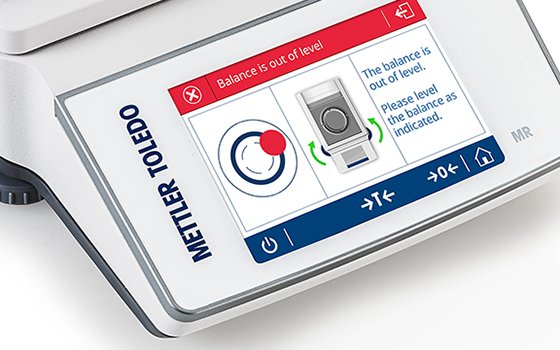 |
What types of analytical balances are available?
Analytical balances may be subdivided into analytical balances and micro-analytical balances. By definition, an analytical balance must have at least 4 decimal places of readability or more (0.1 mg or smaller). Analytical balances enable small quantities to be weighed in relatively large containers. METTLER TOLEDO's micro-analytical balances offer 6 decimal place readability (0.001 mg or 1 µg), and, due to the higher sensitivity of the weighing cell, they have a second inner draft shield and hence a smaller hanging weighing pan. At 32 g and 52 g, the balance capacity is lower than that of an analytical balance.
Occasionally, microbalances are grouped together with analytical balances. However, METTLER TOLEDO classes them separately due to the combination of the higher readability of at least 6 decimal places (1 µg), the capacity of just a few grams, and the different balance construction. These balances are typically used for very high-accuracy applications where the amount being weighed is extremely small, such as weighing particulate matter on filters and precious metal assays.
How is an analytical balance different from a precision balance?
Analytical balances differ from other balance types in their precision, readability, and capacity as well as in their design.
Analytical (left) and precision balance (right):
 |
Compared to precision balances, analytical balances have a higher readability ranging from 1 mg down to 0.001 mg, and a highly sensitive weighing cell. Therefore, analytical balances are capable of weighing very small samples with exceptional accuracy with capacities ranging from 22 to 520 g. Analytical balances are always equipped with a draft shield that protects the sample and the container from air movements and maintains a stable environment. Analytical balances are commonly used for laboratory sample preparation, formulation, differential weighing, density determination, routine pipette testing, and other applications.
See question “What are the types of balances available?” for more information.
What are the types of balances available?
METTLER TOLEDO offers a wide range of balances:
- Ultra-microbalance
- Readability: 0.5 µg – 0.1 µg (0.0005 mg – 0.0001 mg, 0.0000005 g – 0.0000001 g)
- Decimal places: 7
- Minimum weight (5% load, k=2, U=1%): Down to 30 µg (0.03 mg)
- Draft shield type: Round
- Capacity range: 2.1 g – 6.1 g
- Microbalance
- Readability: 1 µg (0.0001 mg, 0.000001 g)
- Decimal places: 6
- Minimum weight (5% load, k=2, U=1%): Down to 82 µg (0.082 mg)
- Draft shield type: Round
- Capacity range: 2.1 g – 10.1 g
- Micro-analytical balance
- Readability: 1 µg (0.0001 mg, 0.000001 g)
- Decimal places: 6
- Minimum weight (5% load, k=2, U=1%): Down to 120 µg (0.12 mg)
- Draft shield type: Rectangular outer + second rectangular inner
- Capacity range: 32 g – 52 g
- Analytical balance
- Readability: 1000 µg – 1 µg (1 mg – 0.001 mg, 0.001 g – 0.000001 g)
- Decimal places: 4-6
- Minimum weight (USP, 0,1%, typical): 1,4 mg
- Draft shield type: Rectangular
- Capacity range: 22 g – 520 g
- Precision balance
- Readability: 1,000,000 µg – 100 µg (1,000 mg – 0.1 mg, 1 g – 0.0001 g)
- Decimal places: 0-4
- Minimum weight (USP, 0,1%, typical): 120 mg
- Draft shield type: None/ Rectangular for 3 and 4 decimal place readability
- Capacity range: 120 g – 64 kg
To ensure you select the correct balance for your application, METTLER TOLEDO established the global weighing standard, Good Weighing Practice™ (GWP®). Our free GWP® Recommendation service can help you select the right balance that meets your particular application needs and process accuracy requirements.
What is the scale division (d) and the verification scale division (e)?
The scale division, d, is the smallest possible increment on a measurement scale. On an analytical balance, d equates to the readability of the balance, which is the smallest difference in weight that can be determined. This should not be confused with the minimum weight of the balance. The verification scale division, e, is relevant for Legal for Trade analytical balances and relates to the maximum number of decimal places that can be used for weight results in direct sales transactions. For example, in the case e = d, the weight in a direct sales transaction can be given using the readability of the balance. So, if d is 0.001 g, all weight results can be given to 3 decimal places. In the case where e = 10d and d = 0.001 g, weight results can only be given to 2 decimal places, i.e., 0.001 g x 10. In this case, on the display of your analytical balance, you may see the third decimal place of the weight result enclosed in brackets, e.g., 2.67(3) g.
How can I weigh small samples on my analytical balance?
The smaller the sample, the less expensive and resource-intensive the analysis. Often only small amounts of samples are available for weighing on an analytical balance. Here are a few simple tips to follow for weighing small samples:
- Before weighing a small sample, make sure you have the right equipment for your application, see "What is the analytical balance's minimum weight?” and “How do I select the right analytical balance for my weighing application?”. Consider using an automatic balance or microbalance for even higher accuracy or a micro-analytical balance for weighing small samples directly into comparably heavy tare containers.
- Reduce measurement errors – the smaller the sample, the higher the relative measurement uncertainty. To reduce errors, choose the ideal place in the laboratory for your balance and “How to avoid analytical balance weighing errors?”
- Weighing small samples directly into the tare container whenever possible, eliminating fumbling with weighing paper and material loss during transfer.
- Using the right tools will improve your weighing experience in terms of speed, accuracy, and ergonomics. Download the Balance Accessories brochure and learn about all it can do to optimize and simplify small sample weighing.
- Your METTLER TOLEDO analytical balance is a powerful instrument that can help you weigh small samples. Built-in quality assurance features, such as the StatusLight and leveling guide, help you to get the right result the first time. Small samples suffer from a high relative measurement uncertainty. Static charges are one of the major contributors to the weighing errors. With XPR analytical balances, you can quantify the weighing error caused by static charges and automatically eliminate them with an optional integrated ionizer.
- An accurate weight determination is essential for small samples. In addition to analytical balances, METTLER TOLEDO also offers automatic and robotic weighing systems. This allows you to minimize variability and a level of accuracy that is unmatched by manual dosing. Learn more here: Automatic Balance | Automated Powder and Liquid Dispensing
How accurate is an analytical balance?
How accurate an analytical balance is can be tested by checking its repeatability, which is the standard deviation of repeated weight values obtained for the same object under the same conditions. An accurate analytical balance gives values that are both true and precise (see “What is the precision of an analytical balance and what is the accuracy of an analytical balance? What is the difference and how to test them?”). The trueness, or closeness of the displayed value to the actual weight applied, can be verified by a sensitivity test. At low loads, repeatability is the largest contributor to the measurement error of an analytical balance, so this specification on the datasheet is critical. For example, the typical repeatability of an XPR205 analytical balance at 5% load is as low as 7 µg. To derive the minimum weight that can be weighed on such an analytical balance, see "What is the analytical balance's minimum weight?”.
What is the performance of an analytical balance?
The performance of an analytical balance refers to its ability to provide accurate and precise measurements in a laboratory setting. Here are some key aspects of performance that are typically considered:
- Accuracy: Accuracy is the closeness of the measured value to the true value. An analytical balance should be capable of providing highly accurate measurements. This means that the measured weight should closely correspond to the actual weight of the sample being measured.
- Precision: Precision relates to the repeatability or reproducibility of measurements. It refers to the consistency of results when weighing the same sample multiple times under the same conditions. A highly precise analytical balance will provide consistent readings with minimal variation, indicating a low level of random error. Repeatability refers to the closeness of results when weighing the same sample multiple times under the same conditions. It assesses the consistency of measurements and indicates how well the balance can reproduce results. A balance with good repeatability will consistently provide similar readings for the same sample.
- Sensitivity: Sensitivity refers to the smallest change in weight that the balance can detect and measure accurately. It represents the smallest increment of weight that can be discerned by the balance. A more sensitive balance can detect smaller changes in weight.
- Readability: Readability refers to the smallest increment that can be displayed on the balance's readout. It indicates the level of detail or resolution in the measurements. A balance with higher readability can display smaller weight differences.
- Linearity: Linearity describes the balance's ability to provide accurate measurements across its entire weighing range. It indicates how well the balance maintains a linear relationship between the applied force (weight) and the resulting output (readings). A balance with excellent linearity will provide accurate measurements throughout its specified range.
- Stability: Stability refers to the ability of the balance to maintain consistent measurements over time. A stable balance will produce similar readings for the same sample, even when weighed at different intervals. This stability is important to ensure the reliability and consistency of measurements.
- Weighing time: The time required for the weighing process can vary greatly between different analytical balances, where a faster weighing time is typically desired. To minimize weighing time, METTLER TOLEDO XPR and XSR analytical balances feature a hanging weighing pan with a grid structure called SmartGrid. It provides less surface area for air drafts in the weighing chamber than conventional pans, resulting in faster stabilization times and availability of results.
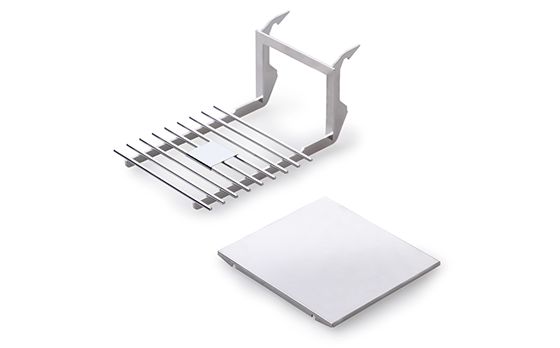 |
In addition, the XPR analytical balances are equipped with the Active Temperature Control Technology to improve temperature stability.
What is an approved balance? When do I need a legal for trade balance?
Approved analytical balances, also called legal for trade analytical balances, are analytical balances that are subject to the local, legal requirements of "non-automatic weighing instruments", as defined in OIML R76. For approved analytical balances, the net weighing results must comply with a higher level of control. The term "approved balance" includes legal-for-trade (LFT) balances, certified balances, and registered balances.
Approved balances support consumer protection and fair trade and may be required in the following cases:
- In certain countries, all balances need to be approved
- Financial transactions based on weight (e.g. vegetables in a supermarket)
- Weight-based pharmaceutical or medicinal applications (e.g. balance used for drug formulation)
- In a court of law where a quantity needs to be determined precisely (e.g. mass of illegal drugs)
Is my analytical balance legal for trade?
Legal for trade, or approved, analytical balances are easy to identify. At METTLER TOLEDO, approved models have a specific model designation: The XPR205 is not an approved model, however, the XPR205/A, XPR205/AC, and XPR205/M are. The suffix letter e.g. A, AC, and M depends on the region of use of the analytical balance. The same principle applies also to other METTLER TOLEDO analytical balance models (XSR, MS, ME, and ML-T).
The descriptive markings of the instrument are on the model label (and type label), according to OIML R76-1:
- Min: minimum capacity
- Max: maximum capacity
- e: verification scale interval (see "What is the scale division (d) and the verification scale division (e)?")
- d: actual scale interval
Further, you can identify an approved analytical balance model by checking whether it has been sealed after manufacture. This prevents the analytical balance from being opened and tampered with by unauthorized persons.
How are analytical balances made?
The first step is to design the analytical balance, taking into consideration the required specifications, such as the maximum capacity, readability, and accuracy. This involves careful engineering to ensure the balance can provide reliable and consistent measurements. All METTLER TOLEDO analytical balances are designed in Switzerland following rigorous techniques. The manufacturing process of our analytical balances follows the below key steps:
- Production and Assembly: Analytical balances are made following a manufacturing process with high-quality materials
- Calibration and Testing: Analytical balances undergo rigorous calibration and testing procedures to ensure their accuracy and precision. This involves comparing the balance's readings against known standard weights.
- Quality Control: Throughout the manufacturing process, strict quality control measures are implemented to ensure that each balance meets the required standards. This involves various inspections, functional tests, and verification of performance parameters.
These are the main components of an analytical balance:
- Frame and Housing: The frame and housing of the balance are usually made from a combination of materials like metal, plastic, and glass. The frame provides structural stability, while the housing protects the internal components from external factors like dust, air currents, and electromagnetic interference.
- Weighing Mechanism: The weighing mechanism is at the heart of the analytical balance. It typically consists of a pan or platform where the sample is placed, a load cell or balance mechanism to measure the weight, and an electronic circuit for signal processing. The load cell converts the force exerted by the sample into an electrical signal that can be measured.
- Readout and Display: The weight readings are typically displayed digitally on an LCD or LED screen. The display includes additional information such as units of measurement, tare function, and calibration status.
- Environmental Controls: Analytical balances often have features to minimize the impact of external factors on measurements. These include draft shields or enclosures to protect the sample from air currents, anti-vibration tables to reduce the effects of vibrations, and temperature compensation mechanisms to account for temperature variations.
What is the most used analytical balance?
The most used analytical balance can vary depending on factors such as the specific industry, application, and individual requirements such as maximum capacity, readability, accuracy, and features like built-in adjustment, data connectivity, and user interface. It is recommended to consider the specific needs of the laboratory, application, and your process requirements before selecting the most appropriate analytical balance. Please get in touch with our experts and request service GWP® Recommendation for free. They will guide you step by step on how to select the right analytical balance for your needs.
Why do I need to level an analytical balance?
Leveling an analytical balance is critical to maintain accuracy during weighing for several reasons:
- Repeatability: Leveling ensures that the weighing surface of the balance is parallel to the ground. This alignment is essential because any tilt or unevenness can introduce measurement errors. It also helps maintain consistent results when weighing the same sample multiple times. If the balance is not level, the distribution of weight on the weighing surface may vary, leading to inconsistent readings. Leveling the balance reduces the risk of uneven weight distribution and improves the repeatability of measurements.
- Stability: Leveling the balance provides stability to the weighing platform. If the balance is not level, it may be more prone to vibrations or disturbances, which can affect the accuracy of the measurement.
- Calibration: Leveling is often a prerequisite before calibrating an analytical balance. Calibration means comparing the balance's readings to known standard weights. If the balance is not leveled during calibration, it may affect the adjustment process, leading to inaccurate measurements. Leveling ensures that the balance is in the correct position for accurate calibration.
- Compliance: Leveling an analytical balance is often required to adhere to industry standards and regulations. Laboratories following quality management systems, such as ISO 17025, typically have specific guidelines for balance leveling. Leveling ensures consistency and traceability in measurements, which is essential for compliance purposes.
A balance out of reference position cannot register the full force of gravity:
 |
Find out more about leveling your analytical balance here: The Importance of Leveling.
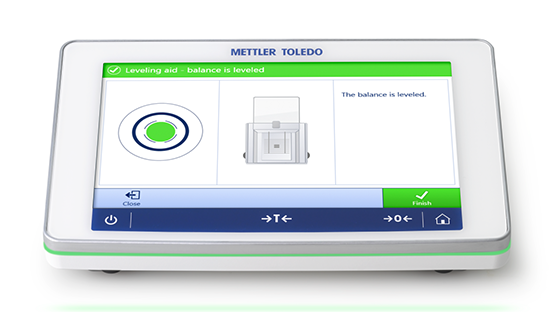 |
How do I level an analytical balance?
To level an analytical balance, you need to adjust the balance position until the weighing pan is parallel to the ground using the adjustable leveling feet and bubble indicators. With level guidance from METTLER TOLEDO, analytical balances can be easily leveled in seconds.
How to use my analytical balance in a sustainable way?
Using an analytical balance in a sustainable way is an important consideration to minimize environmental impact and promote responsible laboratory practices. METTLER TOLEDO analytical balances are designed with sustainability in mind and come with environmentally friendly features that allow you to use your analytical balance in a more sustainable manner:
- High-quality materials and robust construction, as well as easy cleaning, ensure a long balance lifetime, providing an overall low total cost of ownership.
- Ensuring your analytical balance is serviced in due time using METTLER TOLEDO Preventive Maintenance Service, also ensures the long lifetime of your instrument
- The compact footprint of Excellence METTLER TOLEDO analytical balances reduces material needs and emissions during transport.
- Smart features such as sleep mode allow for efficient and economical operation. This helps conserve energy and extends the life of the balance.
- Utilizing electronic data recording and management systems helps you reduce paper usage and improves data accessibility.
- Using minimal sample sizes reduces the amount of material consumed and minimizes waste. METTLER TOLEDO's range of analytical balances offers outstanding performance with low minimum weights, allowing samples to be downsized.
What is the best analytical balance?
The best analytical balance is the one that best suits your intended purpose. The free METTLER TOLEDO Good Weighing Practice (GWP) Recommendation approach provides you with the support you need to select the right analytical balance by matching the performance of your analytical balance and characteristics to your requirements. Your requirements may include tolerances specific to your processes, as well as a minimum weight and maximum capacity according to your expectations. You may also wish to have user management, specific software compatibility, or an approved balance. Whatever it is, METTLER TOLEDO has the analytical balance that is right for you.
What does the DU mean in the XPR Analytical Balance names (example: XPR205DU)?
The DU stands for “Dual Range.” This means the XPR balance has two different weighing capacities, with different resolutions and maximum capacities for each range. This allows the balance to weigh both small and large quantities of samples with a high degree of accuracy.
In the XPR series of analytical balances, the dual range functionality is achieved through an Automatic Range Adjustment (ARA) system that automatically switches between the two ranges based on the weight of the sample being weighed. The ARA system ensures that the balance operates at its optimal performance and accuracy for every sample being weighed.
For example, the XPR dual range balance may have a capacity of 120 g for the high range and 10 g for the low range. The high range will provide a higher resolution and greater accuracy for weighing smaller samples up to 10 g, while the low range will provide a coarser resolution for weighing larger samples up to 120 g.
Overall, the dual range functionality in XPR balances provides a versatile solution for users who need to weigh a wide range of sample sizes and require accurate and precise results for both small and large quantities.
What does DR mean in the XPR Analytical Balance names (example: XPR205DR)?
The DR stands for “Delta Range.” The delta range feature allows users to increase the weighing capacity of the balance while maintaining high precision and accuracy.
For example, an XPR analytical balance may have a standard dual range of 120 g x 0.1 mg on the high range and 10 g x 0.01 mg on the low range. With the delta range feature, the weighing capacity of the balance can be increased to 220 g, while maintaining a precision of 0.1 mg.
The delta range feature allows users to weigh larger samples without sacrificing the accuracy of the measurements, which is especially useful in applications that require high accuracy and precision for both small and large samples.
The delta range feature is enabled through an innovative weighing cell design that allows the balance to adjust its internal configurations, allowing it to provide high accuracy and precision even at higher weighing capacities.
Overall, the delta range feature in XPR analytical balances provides an innovative and versatile solution for users who need to weigh both small and large quantities of samples with high accuracy and precision.
What does the H mean in XPR Analytical Balance names (example: XPR106DUH)?
The letters at the end of the balance name are a combination of two feature indicators. The first, “DU,” as discussed in the FAQ above, indicates the balance has dual range capabilities. The “H” afterwards stands for “Height,” and indicates that this model of balance has a smaller weighing chamber. The draft shields are smaller, and it has a specialized weighing pan area to minimize the effects of air disturbances as much as possible.
What does the Q mean in the XPR Analytical Balance names (example: XPR106DUHQ)?
The “Q” at the end of a balance name indicates that it is an Automatic Balance model. The XPR Automatic Balance is a highly accurate balance capable of dispensing powders and liquids into a variety of containers. More information can be found here: Automatic Balance.
In the case of this example, XPR106DUHQ, this is a balance with the dual range functionality, a smaller weighing chamber with lower draft shields, and automatic dispensing capabilities.
What do the numbers mean in the XPR Analytical Balance names?
In METTLER TOLEDO's XPR balance product line, the numbers in the balance names indicate the maximum weight capacity (in grams) and the readability (in milligrams) of the balance. For example, the XPR205 has a maximum weight capacity of 220 grams and a readability of 0.01 grams (10 milligrams)–2 digits after the decimal point. This is a quick way to decipher the approximate capacity and the readability of each model.
What does the name XPR stand for in the analytical balance?
The XPR in METTLER TOLEDO's XPR balance product line stands for "eXcellence Performance Reliability." This name was chosen to reflect the high level of quality and precision that the XPR balances are designed to provide, as well as their reliability and durability over time. The XPR balance line is used in a variety of applications in laboratory and industrial settings, where accuracy, precision, and repeatability are critical for achieving reliable results.

